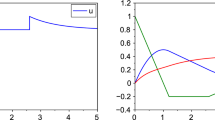Abstract
The aim of this paper is to investigate from the numerical point of view the coupling of the Hamilton-Jacobi-Bellman (HJB) equation and the Pontryagin minimum principle (PMP) to solve some control problems. A rough approximation of the value function computed by the HJB method is used to obtain an initial guess for the PMP method. The advantage of our approach over other initialization techniques (such as continuation or direct methods) is to provide an initial guess close to the global minimum. Numerical tests involving multiple minima, discontinuous control, singular arcs and state constraints are considered.
Similar content being viewed by others
References
Büskens, C.: NUDOCCCS—User’s manual. Universität Münster (1996)
Diehl, M., Leineweber, D.B., Schäfer, A.A.S.: MUSCOD-II Users’ Manual. University of Heidelberg, Germany (2001)
Wächter, A., Biegler, L.T.: On the implementation of a primal-dual interior point filter line search algorithm for large-scale nonlinear programming. Math. Program. 106, 25–57 (2006)
Chudej, K., Büskens, Ch., Graf, T.: Solution of a hard flight path optimization problem by different optimization codes. In: Breuer, M., Durst, F., Zenger, C. (eds.) High-Performance Scientific and Engineering Computing. Lecture Notes in Computational Science and Engineering, vol. 21, pp. 289–296. Springer, New York (2002)
Maurer, H., Pesch, H.J.: Direct optimization methods for solving a complex state-constrained optimal control problem in microeconomics. Appl. Math. Comput. 204, 568–579 (2008)
Clarke, F., Vinter, R.B.: The relationship between the maximum principle and dynamic programming. SIAM J. Control Optim. 25, 1291–1311 (1987)
Cannarsa, P., Frankowska, H.: Some characterizations of optimal trajectories in control theory. SIAM J. Control Optim. 28, 1322–1347 (1991)
Cannarsa, P., Frankowska, H., Sinestrari, C.: Optimality conditions and synthesis for the minimum time problem. Set-Valued Anal. 8, 127–148 (2000)
Cernea, A., Frankowska, H.: A connection between the maximum principle and dynamic programming for constrained control problems. SIAM J. Control Optim. 44, 673–703 (2006)
Pesch, H.J.: A practical guide to the solution of real-life optimal control problems. Control Cybern. 23, 7–60 (1994)
Pesch, H.J., Plail, M.: The maximum principle of optimal control: a history of ingenious idea and missed opportunities. Control and Cybern. (to appear)
Deuflhard, P.: Newton Methods for Nonlinear Problems. Springer Series in Computational Mathematics, vol 35. Springer, Berlin (2004)
Bellman, R.E.: The theory of dynamic programming. Bull. Am. Math. Soc. 60, 503–515 (1954)
Falcone, M.: Numerical solution of dynamic programming equations. Appendix A in [21]
Falcone, M.: Numerical methods for differential games based on partial differential equations. Int. Game Theory Rev. 8, 231–272 (2006)
Pontryagin, L.S., Boltyanski, V.G., Gamkrelidze, R.V., Mishtchenko, E.F.: The Mathematical Theory of Optimal Processes. Wiley–Interscience, New York (1962)
Bryson, A.E., Ho, Y.-C.: Applied Optimal Control. Hemisphere, New York (1975)
Pesch, H.J.: Real-time computation of feedback controls for constrained optimal control problems II: a correction method based on multiple shooting. Optim. Control Appl. Methods 10, 147–171 (1989)
Bettiol, P., Frankowska, H.: Normality of the maximum principle for nonconvex constrained Bolza problems. J. Differ. Equ. 243, 256–269 (2007)
Chitour, Y., Jean, F., Trélat, E.: Genericity results for singular curves. J. Differ. Geom. 73, 45–73 (2006)
Bardi, M., Capuzzo Dolcetta, I.: Optimal Control and Viscosity Solutions of Hamilton-Jacobi-Bellman Equations. Birkhäuser, Boston (1997)
Cristiani, E., Falcone, M.: Fast semi-Lagrangian schemes for the Eikonal equation and applications. SIAM J. Numer. Anal. 45, 1979–2011 (2007)
Bokanowski, O., Martin, S., Munos, R., Zidani, H.: An anti-diffusive scheme for viability problems. Appl. Numer. Math. 56, 1147–1162 (2006)
Bokanowski, O., Cristiani, E., Zidani, H.: An efficient data structure and accurate scheme to solve front propagation problems. J. Sci. Comput. 42, 251–273 (2010)
Tsai, Y.R., Cheng, L.T., Osher, S., Zhao, H.: Fast sweeping algorithms for a class of Hamilton-Jacobi equations. SIAM J. Numer. Anal. 41, 673–694 (2003)
Bardi, M., Falcone, M., Soravia, P.: Fully discrete schemes for the value function of pursuit-evasion games. In Basar, T., Haurie, A. (eds) Advances in Dynamic Games and Applications, Annals of the International Society of Dynamic Games, vol. 1, pp. 89–105 (1994)
Soravia, P.: Estimates of convergence of fully discrete schemes for the Isaacs equation of pursuit-evasion differential games via maximum principle. SIAM J. Control Optim. 36, 1–11 (1998)
More, J.J., Garbow, B.S., Hillstrom, K.E.: User Guide for MINIPACK-1. Argonne National Laboratory Report ANL-80-74 (1980)
Hairer, E., Nørsett, S.P., Wanner, G.: Solving Ordinary Differential Equations I. Springer Series in Computational Mathematics, vol. 8. Springer, Berlin (1993)
Gergaud, J., Martinon, P.: Using switching detection and variational equations for the shooting method. Optim. Control Appl. Methods 28, 95–116 (2007)
Goddard, R.H.: A method of reaching extreme altitudes. Smithsonian Inst. Misc. Coll. 71 (1919)
Maurer, H.: Numerical solution of singular control problems using multiple shooting techniques. J. Optim. Theory Appl. 18, 235–257 (1976)
Oberle, H.J.: Numerical computation of singular control functions in trajectory optimization. J. Guid. Control Dyn. 13, 153–159 (1990)
Tsiotras, P., Kelley, H.J.: Drag-law effects in the Goddard problem. Automatica 27, 481–490 (1991)
Seywald, H., Cliff, E.M.: Goddard problem in presence of a dynamic pressure limit. J. Guid. Control Dyn. 16, 776–781 (1993)
Bonnans, F., Martinon, P., Trélat, E.: Singular arcs in the generalized Goddard’s problem. J. Optim. Theory Appl. 139, 439–461 (2008)
Camilli, F., Falcone, M., Lanucara, P., Seghini, A.: A domain decomposition method for Bellman equations. In: Keyes, D.E., Xu, J. (eds.) Domain Decomposition Methods in Scientific and Engineering Computing. Contemporary Mathematics, vol. 180, pp. 477–483. AMS, Providence (1994)
Author information
Authors and Affiliations
Corresponding author
Additional information
Communicated by H.J. Pesch.
Rights and permissions
About this article
Cite this article
Cristiani, E., Martinon, P. Initialization of the Shooting Method via the Hamilton-Jacobi-Bellman Approach. J Optim Theory Appl 146, 321–346 (2010). https://doi.org/10.1007/s10957-010-9649-6
Published:
Issue Date:
DOI: https://doi.org/10.1007/s10957-010-9649-6




